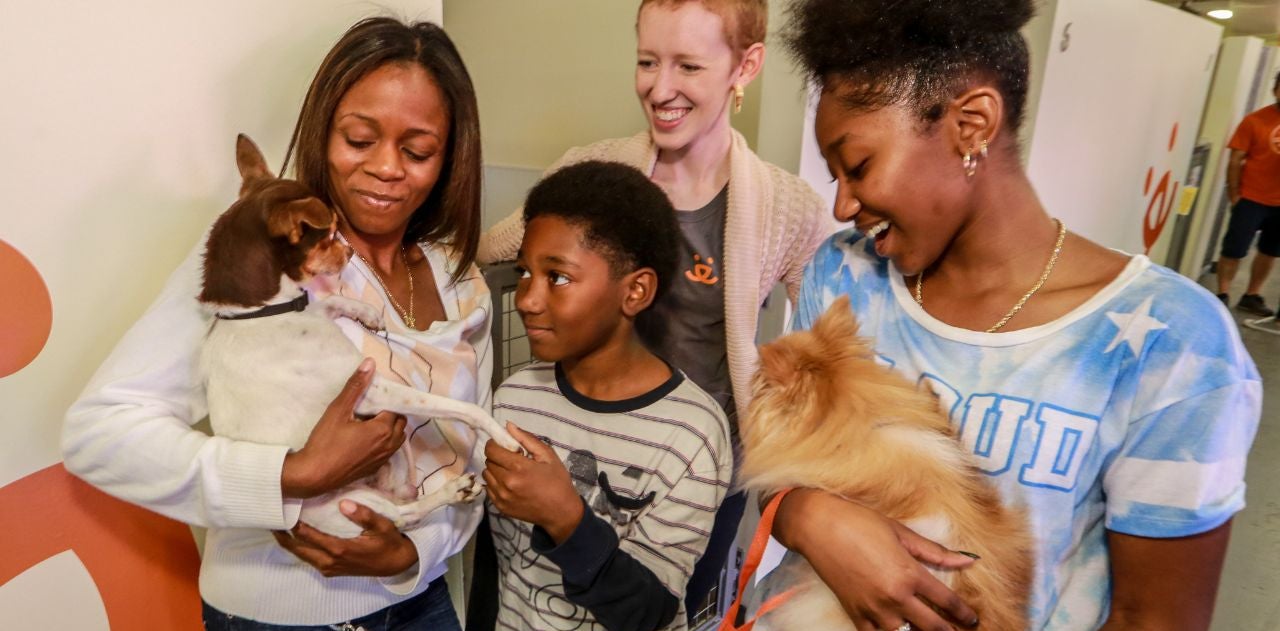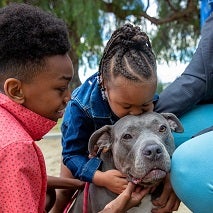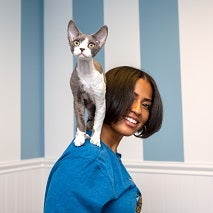
What’s Next: Reducing Racism in Animal Welfare
This week, eight African American, Hispanic, Native American and mixed-race Best Friends staff members discuss what steps they feel we should be taking to change the face of animal welfare to one that is more inclusive and welcoming to people of all backgrounds. And the first is to take stock of where we are today.
Assess your organization
Before we can understand to what degree racism has infected our work, shelters and rescues must consider who they are and their community’s true needs. What audience are you serving? What do your staff and your board members look like? What programs do you offer? Does your mission fit the community where you are located? It’s hard to say you are a shelter serving the public if you live in a largely Spanish-speaking area but have an all-white staff that only speaks English.
Likewise, who are the people coming into your organization to adopt? And for those who are not coming to you for services, why might that be the case?
“Organizations need to know where they’re at today to be able to set goals around diversity, equity and inclusion,” says senior director of culture and talent José Ocaño. “This is about the adoption of a new philosophy, and that requires us to evaluate the system before we can change the status quo. Then we can explore how best to meet people where they are and speak to our whole community, as well as know how to attract staff, donors and board members from all kinds of backgrounds.”
Re-evaluate hiring practices
The biggest priority when hiring is obviously to find the best match for the job, but we often exclude people who might be perfect for our culture. Take a hard look at what is required of applicants or even volunteers, like demanding a certain level of college education or eliminating individuals with a history of non-violent crimes.
“We are not lowering our standards but rather, we need to know that some of the required skills, experience and education are arbitrary in the first place and not a value-add as so much in our industry can be learned on the job,” says José
“We are also missing out on people who have a lot to give but can’t come into our field despite having years of hands-on experience,” adds community cat programs (CCP) outreach specialist Leah Long. “And sometimes the staff we do have can’t meet the needs of the community. I live in a multiracial, multilingual community where the shelter is staffed by all white animal control officers who don’t speak other languages. That creates real barriers.”
“I think it’s so important to have bilingual staff because without them it’s really hard to communicate with the public,” agrees CCP coordinator Carol Reyes. “When I first started working at a shelter, there was another animal welfare organization in a nearby community that would transfer all of their Spanish voicemails to me. I always wondered what would happen if I wasn’t there to talk to those people?”
Marc Peralta senior director of national mission advancement notes that we also need to seek outside expertise to engage in active rather than passive recruitment efforts (e.g. social media) and reach a new audience of job applicants—not to mention volunteers, donors and board members.
“When you are a leader, but you don’t have the internal expertise, you find people with different experiences who can bring new eyes to the issue,” he says. “And when we have people in our organizations who do represent a new perspective, we need to raise their voices.”
For CCP supervisor Kirstie James, that means diversifying conference speakers.
“They don’t necessarily have to talk about diversity, but if they come from different cities and backgrounds that creates a richer conversation,” she says.
José agrees with both points.
“We need to ensure that people of color have ways to advance into positions at all levels within this movement. If we don’t, we will continue to miss out on a ton of talented people who have plenty to give.”
Drop the barriers to inclusion
Everyone interviewed for this editorial noted how frequently the issue of race or socioeconomic status is used as a subtle—or not so subtle—means to keep people from participating in the movement.
“I encounter a lot of people in animal welfare who are comfortable saying ‘these people can’t afford to go to the vet, they’re a bad pet parent’,” says Dinah Sepulveda, CCP coordinator. “But my family couldn’t afford regular vet visits and we loved our pets like they were our children.”
“We must stop looking up income demographics to see who can afford a pet and look at reaching more people,” Kirstie agrees. “One main way to do that is to get out into more communities in areas that are out of our comfort zone. Literally every weekend there is an adoption event in my white, middle-class neighborhood, and that made me realize that I never saw adoption or volunteer recruitment events when I lived in a Black community growing up.”
“We need to reach out farther than our base to communities of color and expand the movement out further,” she says. “We should be looking for reasons to adopt to a more diverse group of people rather than looking for reasons not to.”
Change the narrative
Ushering in change also means looking at our long-held narrative about “the problem” of homeless pets through a new lens.
“For a long time when I was working in shelters, I did think ‘people suck and they don’t care and it’s an overpopulation problem.’ But the problem within sheltering is reflective of much deeper issues,” says Jose. “The root causes of why animals come into shelters are about housing and education disparities and socioeconomic status, and those are all byproducts of institutionalized racism. It’s far more complex than ‘people don’t care.’ How you think about a problem and what you deem is the problem will inform the solution.”
And employee relations specialist Dawn Binion-Stewart points out that thinking about a problem through a new lens means listening closely to people with other experiences.
“It’s important to really listen so you can understand the point of view that someone is expressing before you try to talk to them,” she says. “For example, I hear the assumption ‘no one believes in spaying and neutering in the Black community,’ But there is relevant context here that is part of our heritage when breeding was controlled for Black people during slavery.
“Today there is a strong belief that we have a right to have children because that was taken away from us in the past,” she explains. “That extends to animals, too. I often hear ‘it’s not right to take away the nurturing opportunity of motherhood.’ When we understand an issue from another person’s point of view, then we can talk about it in a way we both can understand.”
The language we use to talk about these issues is important, too.
“We need to focus more on the ‘us’ as a collective community rather than ‘those’ communities over there, and consider what it means to say we are ‘collaborating’ with people instead of ‘reaching out’ to them,” says legislative attorney Akisha Townsend-Eaton. “We need to examine how our choice of words might prevent another person from being recognized as human being, a contributor, as someone with a solution.”
Recognize where solutions already exist
The future of animal sheltering is one that is housed within communities and not brick-and-mortar facilities, but in many Black communities the future is already here.
“Most of my family’s pets were strays that they fed and took in, or pets from friends who couldn’t keep them anymore,” says Akisha. “As an industry we are trying to keep pets from coming into the shelter in the first place, but that is already happening within African American communities. It’s an untold story in our field.
“When a person brings a pet into their home, they are saving the shelter the time and expense for housing and eventually killing a pet that is now in a home,” she continues. “What if instead of looking at spay/neuter vouchers as hand-outs to people who are part of a problem, vouchers were used to thank people for giving a pet a home? We should recognize what communities are already doing and leverage those people to make sure we don’t have homeless pets.”
Akisha’s suggestion about vouchers might be a tough ask of an industry where people commonly joke that they like animals more than people. But as James Evans, president of Companions and Animals for Reform and Equity (CARE) noted, “only through love of humanity will we be able to meet people with curiosity and not riddled with judgment and biases.”
“If we continue being exclusive, whether its intentional or not, we have no right to gripe that animals are dying because we are part of the problem,” says José. “If you are not making people an integral part of what you do, then you aren’t saving as many animals as you can and that's a missed opportunity.”
Refuse to stay silent
Moving toward a time when animal welfare will be field noted for its diversity, inclusiveness and equality will take time, but every step is a critical one. Even while we await the changes that we seek in this movement, we can do something that will stop racism and discrimination in its tracks today: refuse to stay silent.
“If someone is comfortable enough to say something ugly and hateful, you have to be comfortable enough to dive into that uncomfortable situation,” says Dinah. “Make it known that you’re here, you’re paying attention and when you see these things happening you will say something about it. Speaking up may not change a person’s point of view, but maybe they will treat someone as an equal the next time that situation comes up.
“I know that right now we are fired up, but we can’t let this fizzle out,” she adds. “We can’t let things go back to how they’ve been longer than we’ve been alive. I am making a promise to myself that I will have these conversations. I will keep this fire lit.”
Liz Finch
Senior Writer, Best Friends Network
Best Friends Animal Society
If you enjoyed this program spotlight, you can find our complete catalog of spotlights here.
 Activating DEI in Animal Welfare Town Hall
Activating DEI in Animal Welfare Town Hall Culture Initiatives Playbook
Culture Initiatives Playbook Embracing Diversity in the Animal Welfare Movement Vlog
Embracing Diversity in the Animal Welfare Movement Vlog